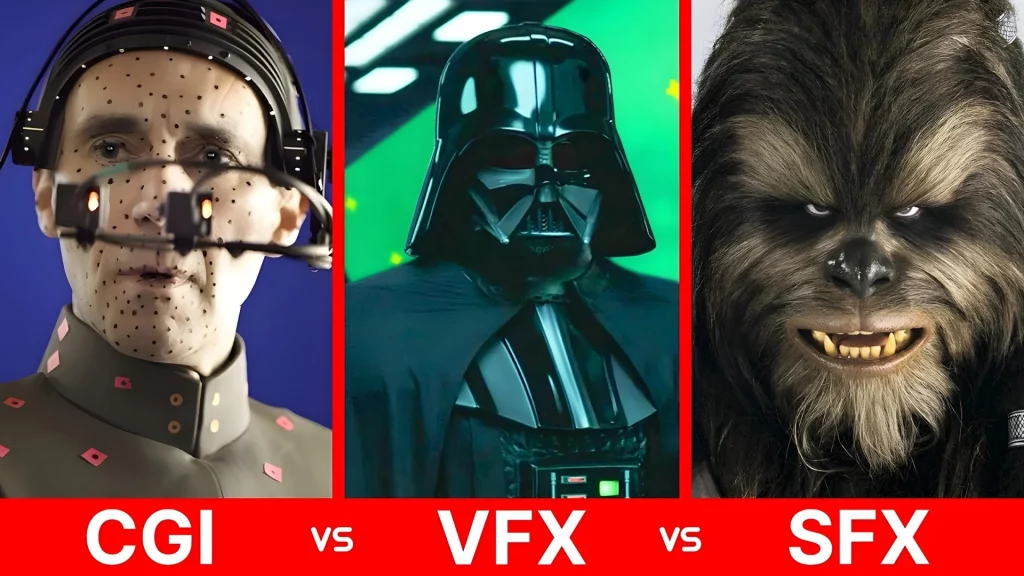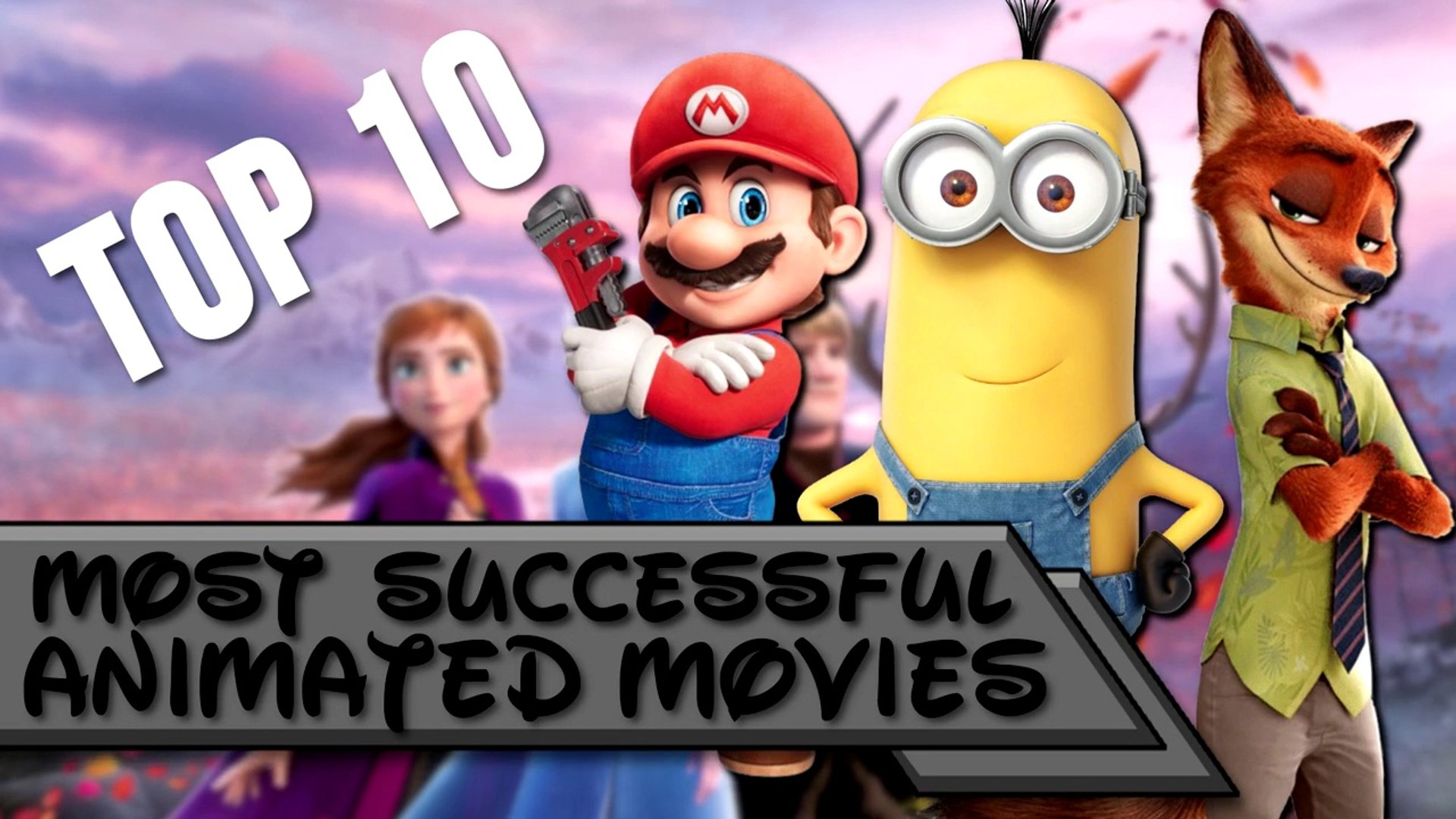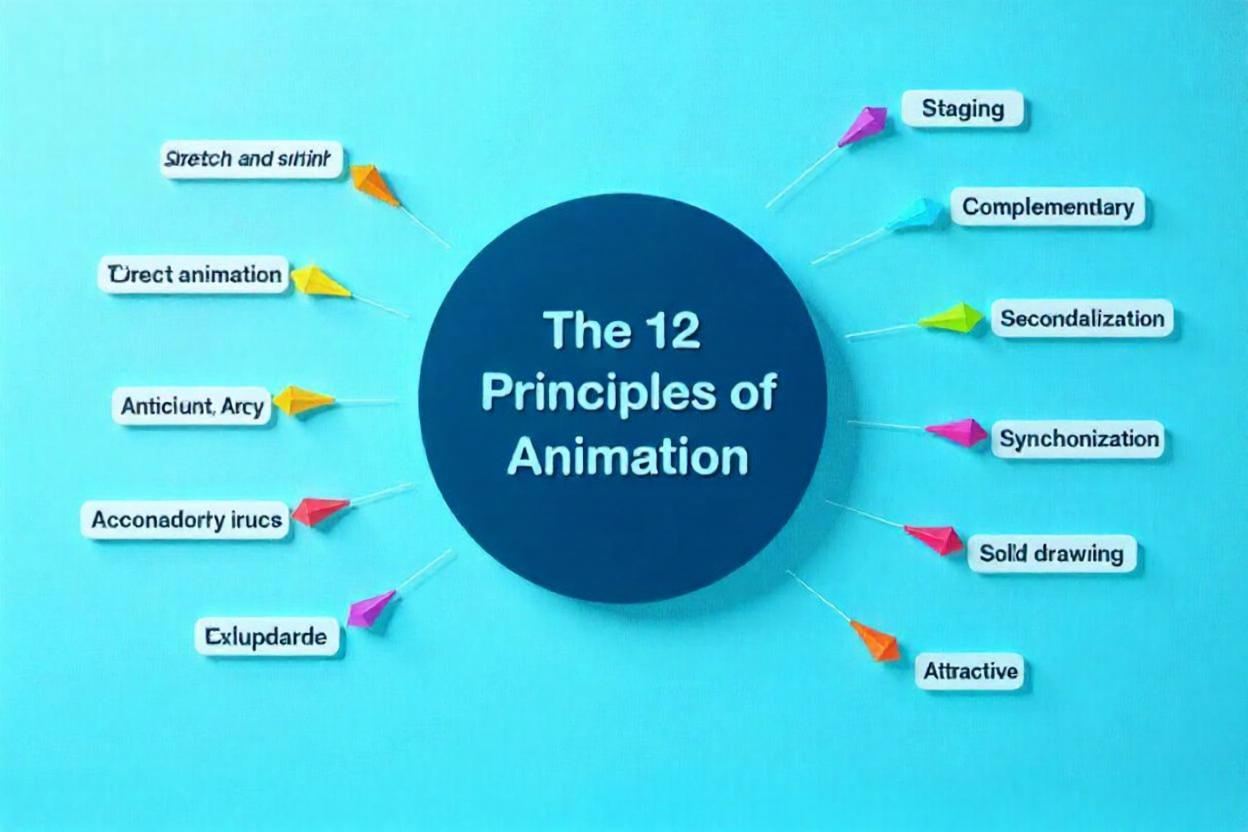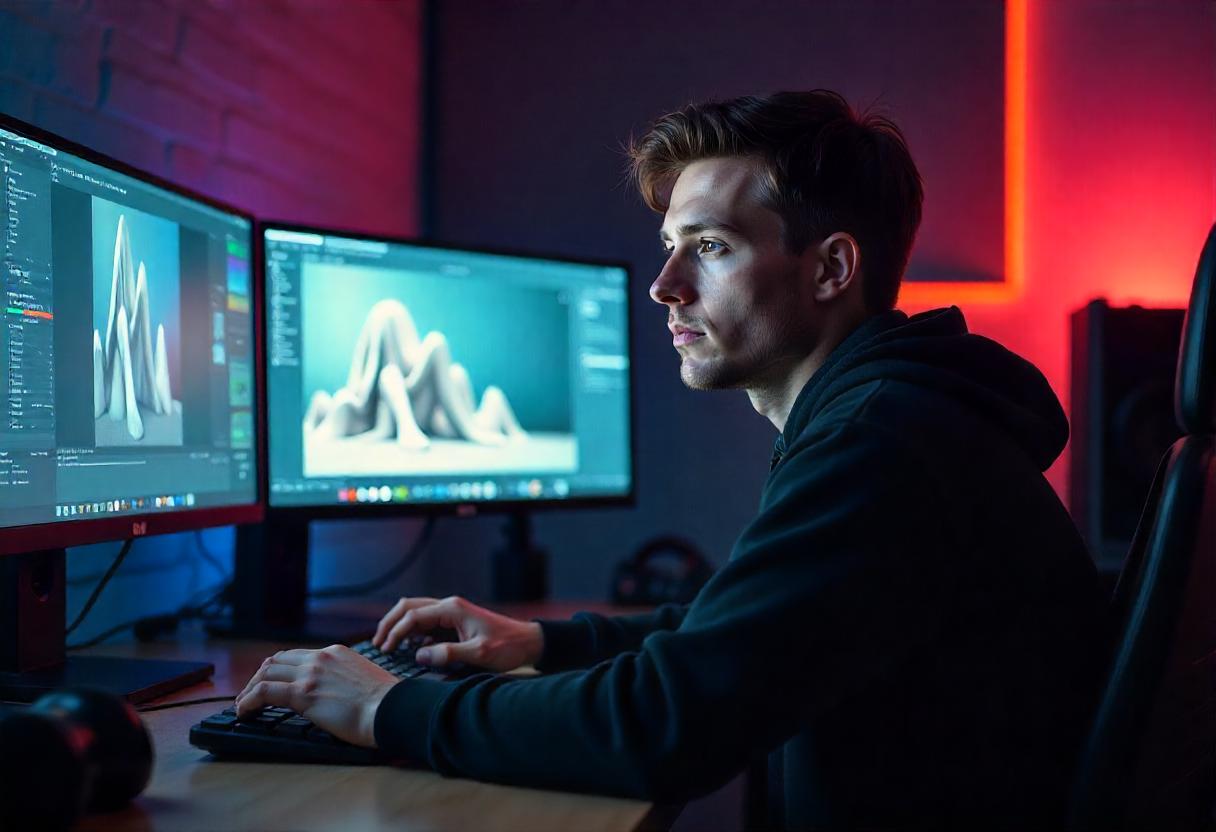VFX vs. CGI vs. SFX: Understanding the Differences & How They Work
We are moving in this world at a very fast pace. I believe if you work in film and or in the video creation world, then you would have probably heard of “SFX,” but you may not know what the term means. In this blog, I will give you a brief of VFX vs CGI vs SFX. How are they working together? What’s the difference between them ?
In filmmaking, there are various effects that get incorporated into videos to add enticing visual illusions and sound effects to drive a specific message.
If you think you are an aspiring filmmaker or video maker, you should definitely know more about visual, sound, and special effects. Whether you’re exploring animation courses after 12th or diving into video game development courses, this blog will give you all the insight you need to feel confident about using VFX
What is VFX?
It deals with creating visuals that look realistic and accurate by combining real-life video and computer-generated imagery (CGI). In short, VFX is the manipulation of CGI and its blending with recorded live activity for a movie.
Do you want free career counseling?
Ignite Your Ambitions- Seize the Opportunity for a Free Career Counseling Session.
- 30+ Years in Education
- 250+ Faculties
- 30K+ Alumni Network
- 10th in World Ranking
- 1000+ Celebrity
- 120+ Countries Students Enrolled
VFX is adaptable as it can be used to create a variety of videos using live footage visuals, edited videos, and computer-generated imagery. The most widely used tool in visual effects is a green screen, which is a background that can be quickly and easily removed from behind a person after creating the required scene on the background.
Visual Effects is the process of creating and manipulating imagery that is generated by computers and combining it with live action shots, when it comes to film making or any kind of video visuals. This used to be very expensive, dangerous and maybe time consuming to do to get an output that would be difficult to get on film. VFX, now a days is easily accessible through animation and compositing software.
Timing: VFX is one of the most important elements in making a film and is usually integrated during the post production of the film, but the timing of this is choreographed during the planning stage.
Book Now →
VFX Working (Visual Effects)
Used for: Creating visuals that are impossible or impractical to film in real life.
Typical Workflow:
- Concept Art – Artists create a visual blueprint of the scene.
- 3D Modeling – Digital artists build 3D assets like creatures, buildings, or environments.
- Texturing & Rigging – Adding surface detail and skeletons for animation.
- Animation – Animators bring the 3D models to life.
- Simulation FX – Fire, water, smoke, explosions are digitally simulated.
- Compositing – All digital elements are combined with live-action footage.
- Color Grading & Final Output – Everything is polished to match the tone and lighting.
Example: Superhero flying through a digitally created cityscape.
VFX & SFX Careers: Roles, Descriptions & Top Recruiters
Read Also: Top 7 Creative Careers in High Demand Right Now
Do you want free career counseling?
Ignite Your Ambitions- Seize the Opportunity for a Free Career Counseling Session.| Job Role | Description | Top Hiring Companies |
| VFX Supervisor | Oversees the entire visual effects process from pre to post-production. Collaborates with the director and VFX team to ensure the final output aligns with the vision. | Red Chillies VFX, Prime Focus, MPC, Technicolor, DNEG |
| Roto Artist | Isolates objects or characters frame by frame so that backgrounds can be changed or effects added. Works heavily in compositing pipelines. | MPC, Framestore, DNEG, Technicolor, BOT VFX |
| Match Move Artist | Tracks the camera movement in live footage so CGI elements can be perfectly integrated. They bridge the gap between real and computer-generated worlds. | DNEG, Technicolor, Redefine, Tau Films |
| Compositor | Combines various visual elements (live action, CGI, matte paintings) into a single shot, ensuring seamless blending, color correction, and realism. | Framestore, MPC, Red Chillies VFX, yFX (YRF) |
| Concept Artist | Creates visual sketches and design concepts for characters, environments, and props during pre-production. Sets the visual tone for the VFX team. | Ubisoft, Lakshya Digital, Technicolor Games, PhantomFX |
| Digital Paint Artist | Cleans up frames, removes unwanted elements, restores damaged footage, and ensures the shot looks polished and error-free. | Technicolor, Trace VFX, Red Chillies VFX |
| Layout Artist | Plans the camera angles, shot composition, and scene staging for CGI or animated scenes. Provides the framework for animators and VFX teams. | Technicolor, DNEG, Xentrix Studios |
| Matte Painter | Designs realistic or fantasy backgrounds like alien worlds, cities, and landscapes that cannot be filmed in real life. | MPC, ILM, DNEG, Makuta VFX |
| Technical Director (TD) | Solves technical challenges, writes tools/scripts, and ensures smooth functioning of the VFX pipeline. Often specializes in lighting, rigging, or FX. | DreamWorks, DNEG, Pixar (globally), Technicolor |
Top 5 Types of VFX
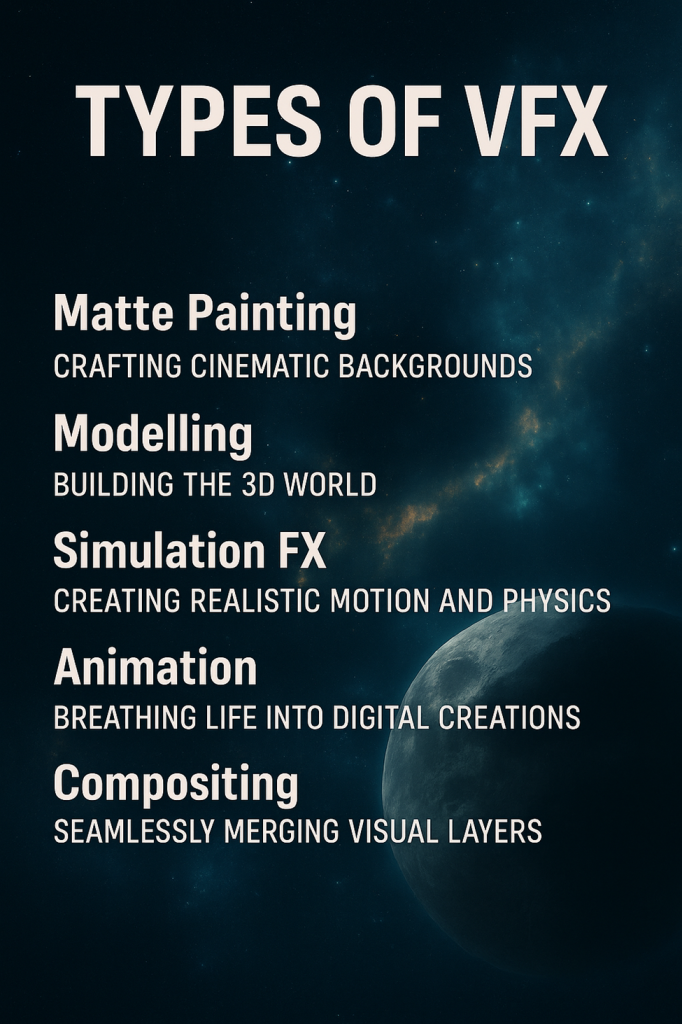
1. Matte Painting
Matte paintings are used to create backgrounds that do not exist in reality, such as huge castles, old cities, or fantasy worlds. They are painted digitally and added to live action footage.
This kind of imagery consists of a combination of different types of images and objects, which are merged together to form a single image of the desired output with further editing.
Example:
– Scenes of old cities and snowy areas created in Game of Thrones.

Read Also: 10 Types of Animation with Examples and How They Work
2. Modelling
This process is to create 3D objects, characters and environments digitally. In this, a digital 3D form of an object is created through software.
Example:
– Creating a digital model of a robot, car or animal.
3. Simulation FX
This category simulates natural and dynamic effects such as fire, water, smoke, explosions or movement of hair and clothes.
Example:
– Effects of destruction, fire, and debris in the Avengers films.

Picture Caption:- Scene of Avengers End Game where VFX and SFX are used, Making these types of vfx and sfx are taught in vfx course
4. Animation
In this, a character or object is given movement so that it looks lifelike. Both 3D and 2D animation fall into this category.
- 2D Animation – This kind of animation refers to the manipulation of images and 2d vector graphics. This process includes techniques such as traditional animation, onion skinning, interpolated morphing and rotoscopy.
- 3D Animation – This refers to the creation of 3 dimensional graphics from animation. The animator receives a rigid model and works to create the illusion of movement.
Read Also: What is Motion Graphics Animation? Uses in Marketing and Media
Since animation has become such a huge part of media, there are jobs available for those who live and breathe this profession. There are various types of jobs available with respect to the animation field:-
- 3D Modeler
- Ragging Artist
- Texturing Artist
- Lighting Artist
- 2D and 3D Animator
There are many other segments in all these types of animation, but let’s see what VFX (Visual Effects) is that will amaze you.
Example:
– Dragons flying or the actions of animated characters.
5. Compositing
This process combines different visual elements (such as video footage, matte paintings, CGI) together to create a final scene. It also includes removing the green screen and adding a background.
Example:
– Flying scenes or space scenes in superhero movies.
What is SFX ?
It means sound effects. Which is a completely different field, it is basically – sound of explosions fire, sound of rain or any sound that is recorded to recreate the real action happening on screen. This has been going on since a very old time, when there were no computers and there was no 3D, so all these explosions, mechanical robots and any live effect had to be created on the set in post-production instead of CG.
Another meaning of SFX is special effects and it can be used with visual effects or they can be used alone. But nowadays we can create all the simulations of fires and explosions and then rain using computers. This is called FX or digital effects in the shot.
SFX Working (Special Effects / Practical Effects)
Used for: Effects created physically during filming.
Typical Workflow:
- Planning & Safety Testing – Effects team designs and tests practical stunts (e.g., explosions).
- Mechanical Setup – Use of rigs, prosthetics, or props.
- On-Set Execution – Filming the effect live (e.g., glass breaking, rain machines).
- Camera Enhancement – High-speed cameras or slow-mo to enhance the effect.
- Optional VFX Support – Sometimes VFX is added later to enhance or blend with SFX.
Example: A real car explosion on a movie set, enhanced with debris shot into the air using air cannons.
What is CGI?
Which are used in the field of post production. So the first is – CGI. It means computer generated imagery. This is 3D, which you see on the screen and it is done using a computer. That is why it is called computer generated imagery. It can be a video game, a 3D animation or even a model created in a computer. But it does not include live-action shots.
Read Also: What is 3D Animation? Process, Applications & Examples
CGI Working (Computer-Generated Imagery)
Used for: Fully digital creation of characters, environments, and actions.
Typical Workflow:
- Storyboard & Scene Planning – Directors and artists plan CGI-heavy scenes.
- Modeling – Artists create digital models of characters or objects.
- Shading & Texturing – Realistic surfaces are created (skin, metal, fur, etc.).
- Rigging & Animation – Skeletons and controls are added for movement.
- Lighting & Rendering – Lights are simulated, and the image is processed frame-by-frame.
- Integration into Scene – The CGI is composited into live-action or animated backgrounds.
Example: A fully CGI dragon flying over a fantasy kingdom.
VFX vs Animation: What is the Difference?
We have all seen and heard about animation and VFX being very important in the new time and age. Movies, advertisements have become a part of the media and a very important part of a completely new industry. But do you know what exactly it is and what the difference is between these two disciplines? Let us take a beautiful plunge into the unknown and look into it a little.
What is Animation?
Animation is the process by which images are used to bring about the illusion of motion by the rapid movement of those images in a sequence.
Animation can be recorded or stored in a variety of devices and formats. Some recordings will be on flip books, video tapes, motion picture movies or digital media and some of the formats it is stored on are digital video or flash animation.
Read Also: CGI vs Practical Effects: Pros, Cons & Best Uses in Film
The first signs of animation discovered were given 5000 years ago in Iran where explorers found an artifact that appeared to show a Desert Ibex jumping to eat leaves from a tree.
Final Verdict:
This blog gave you a clear understanding of the key differences between VFX, CGI, and SFX—three essential components that shape the magic behind movies, TV shows, and games. Whether it’s enhancing reality, creating digital worlds, or using practical on-set effects, each technique plays a crucial role in visual storytelling.
If you’re passionate about animation and dream of building a career in this dynamic industry, AAFT School of Animation is the perfect place to begin your journey. From mastering CGI and VFX to exploring traditional techniques, our comprehensive animation courses and visual effects courses are designed to turn your passion into a profession. With expert mentorship, hands-on learning, and real industry exposure, you’ll gain the skills and confidence to thrive in the world of animation.
So why wait? Enroll in our 3D animation courses today and bring your imagination to life with AAFT!

Aaditya Kanchan is a skilled Content Writer and Digital Marketer with experience of 5+ years and a focus on diverse subjects and content like Journalism, Digital Marketing, Law and sports etc. He also has a special interest in photography, videography, and retention marketing. Aaditya writes in simple language where complex information can be delivered to the audience in a creative way.


